Table of Contents
Table of Contents
In a world where every second counts, one crucial metric that often flies under the radar is: Network Response Time. You might be wondering, "What exactly is network response time, and why should I care about it?"
In this blog post, we're going to break down the concept of network response time into digestible bits (pun intended), and we'll explore why it's a game-changer for businesses of all sizes. So whether you're a small startup looking to optimize your online presence or a multinational corporation aiming to streamline your global network, this post has something for you.
We'll delve into the nitty-gritty details of what network response time is, why it's vital for your business, and most importantly, how you can effectively monitor it. Trust us; by the time you're done reading, you'll not only understand network response time but also be armed with the knowledge to ensure it's working in your favour.
So, if you're ready to unlock the secrets of network response time and take your business to the next level, let's dive right in!
Network Response Time in networking, often abbreviated as NRT or simply response time, is a critical network metric in the realm of computer networking and information technology.
It refers to the time it takes for a network system or a computer to respond to a request or a query initiated by a user or another system. In simpler terms, it measures the speed at which data packets travel from the sender to the receiver and back. It’s a key performance metric that affects how fast websites load, how quickly apps respond, and how smooth real-time communication (like VoIP or video calls) feels.

- A device (like your laptop) sends a request to a server.
- The server processes the request and sends back a response.
- The total time this round-trip takes is the network response time.
- Latency: The delay in data travel time across the network.
- Bandwidth: How much data the network can handle at once.
- Network Congestion: High traffic can slow down responses.
- Packet Loss: Lost or dropped packets mean retransmissions, increasing response time.
- Routing & Hops: The number of network devices (hops) between the source and destination impacts speed.
Fast response times mean smoother browsing, better video calls, and more efficient business operations. If response time is slow, users experience lag, buffering, or even failed transactions. Keeping response times low is key to a great user experience!
Network response time encompasses several components, each of which contributes to the overall delay:
Transmission Delay: This is the time it takes for data to travel from the sender to the receiver over the physical medium, such as Ethernet cables, optical fibres, or wireless connections. It depends on the distance between the two points and the speed of the transmission medium.
Propagation Delay: Propagation delay accounts for the time it takes for data to propagate through the network medium. It's influenced by the speed of light in the medium and the distance data needs to travel.
Processing Delay: Within network devices like routers and switches, there is a processing delay as these devices inspect and route packets. This delay can be affected by the device's processing power and workload.
Queuing Delay: In situations where multiple packets are waiting to be processed, they form a queue. Queuing delay is the time packets spend waiting in this queue before they can be processed and forwarded.
Jitter: Jitter is the variation in network response time. It can be caused by congestion, network traffic spikes, or varying speeds in data transmission. Consistent and low jitter is crucial for real-time applications like voice and video calls.
Packet Loss: When network congestion is severe, packets may be dropped and cause packet loss. Re-sending lost packets increases response time as the receiver needs to request retransmissions.
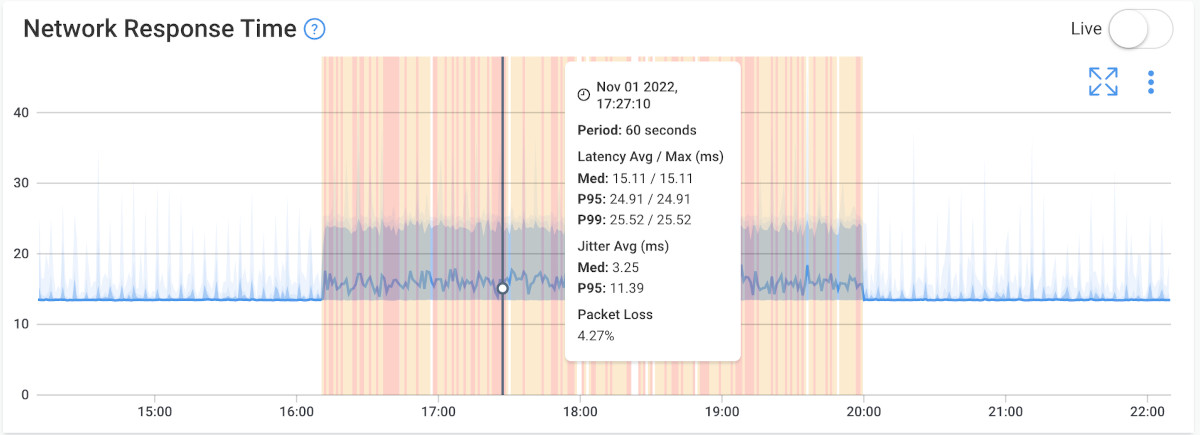

Network response time is a vital performance indicator for businesses and organizations, especially those reliant on digital services, cloud computing, and real-time applications. Monitoring and optimizing network response time is crucial for businesses to ensure their networks operate efficiently, and reliably, and meet the demands of their users and customers.
An efficient network with low response times ensures faster data access, smoother communication, and improved user experiences. On the other hand, slow response times can lead to user frustration, decreased productivity, and potential revenue loss. Let’s look into that in more detail.
Ready to take control of your network's performance and ensure optimal response times for your business? Look no further than Obkio's Network Performance Monitoring tool. With Obkio, you can:

- Monitor Network Response Time: Gain real-time insights into your network's response time, allowing you to identify bottlenecks and latency issues before they impact your operations.
- Proactively Address Issues: Detect and troubleshoot network problems swiftly, reducing downtime and minimizing the impact on your users.
- Optimize User Experience: Ensure your employees and customers enjoy a seamless online experience with faster load times and smoother interactions.
- Meet SLAs with Confidence: With precise monitoring and reporting, you can confidently meet your Service Level Agreements, fostering trust with your clients and partners.
- Enhance Productivity: Empower your team to work efficiently without the frustration of slow network response times.
Take the first step towards network performance excellence today. Try Obkio's Network Performance Monitoring tool and see the difference it can make for your business.

Network Response Time is measured by determining the time it takes for data to travel from a source to a destination and back again. This round-trip time is commonly referred to as "latency" and is typically measured in milliseconds (ms).
Understanding the nuances of network performance metrics is essential for optimizing your digital operations. Two frequently used terms in this realm are 'Network Response Time' and 'Latency.' While they might sound similar, they carry distinct meanings and applications. In this section, we'll unravel the differences between these two crucial metrics, helping you navigate the intricacies of network performance assessment with clarity and precision.
Network Response Time:
Network Response Time, often referred to simply as "response time," is a broader measurement that encompasses the time it takes for a network or system to respond to a request or an action initiated by a user or another system. This response can include not only network latency but also other factors like processing time at the destination, queuing delays, and application processing time.
- Components: Network Response Time includes various components, such as transmission delay, propagation delay, processing delay, and queuing delay, in addition to latency. These components together make up the total response time experienced by the user or application.
- Measurement Units: Response time is typically measured in milliseconds (ms) and represents the total time it takes for a request to go from the sender to the destination and back.
- Use Case: Response time is often used in a broader context to assess the overall performance of a network or application from a user's perspective. It reflects the end-to-end experience, including any delays introduced by the application itself or network components other than latency.
Latency:
Latency, often referred to as "network latency" or simply "ping time," specifically measures the time it takes for data to travel from a source to a destination (usually in a round-trip fashion) within a network. It focuses solely on the time delay introduced by the physical transmission of data over the network medium and the time taken for data to propagate.
- Components: Latency primarily includes transmission delay (the time taken to send data) and propagation delay (the time taken for data to travel over the network medium). It does not consider processing delays, queuing delays, or application-specific factors.
- Measurement Units: Latency is also measured in milliseconds (ms) and represents the time it takes for a data packet to travel from the sender to the destination and back.
- Use Case: Latency is often used to assess the responsiveness and efficiency of the network itself. It's a crucial metric for real-time applications, like online gaming or VoIP, where minimizing delays is essential to provide a smooth user experience.
In summary, the key difference between Network Response Time and Latency lies in their scope. Network Response Time is a more comprehensive measurement that considers all factors contributing to the response time experienced by users or applications, including network latency.
Latency, on the other hand, specifically focuses on the delay introduced by the network's physical transmission and propagation of data. Both metrics are essential for assessing and optimizing network performance, but they serve slightly different purposes.
Learn how to measure latency with Obkio’s Network & Latency Monitoring tool. Check for latency in your network & analyze latency measurements.
Learn more

Good vs. bad network response times depend on what you're using the network for. Here’s a quick breakdown of what’s considered fast, acceptable, and slow response times:
- < 50ms (Excellent): Ideal for real-time applications like VoIP, video conferencing, and online gaming. Users will experience near-instant responsiveness.
- 50-100ms (Good): Still good for most applications, including web browsing, streaming, and cloud services, with minimal delays.
- 100-200ms (Acceptable): Noticeable lag may start to appear, especially in real-time applications. This is still manageable for general browsing and basic business applications.
- 200-500ms (Slow): Performance issues become obvious, leading to buffering in video streams, sluggish web pages, and choppy VoIP calls.
- > 500ms (Very Bad): Unacceptable for most tasks. At this point, users experience significant lag, failed requests, and major disruptions in communication.

What’s Considered "Good" Network Response Time by Application Type?
- VoIP Calls & Video Conferencing (Zoom, Teams, Skype) → < 100ms (preferably < 50ms)
- Online Gaming → < 50ms is ideal, 50-100ms is okay, 100+ms causes lag
- Web Browsing & General Business Apps → < 200ms is good, but slower can cause noticeable delays
- Streaming Video (Netflix, YouTube, etc.) → < 150ms for smooth playback, > 200ms can cause buffering
- Cloud Applications (Google Docs, CRM, SaaS tools) → < 100ms is ideal for seamless performance
When measuring network response time, there are certain factors like the location of the test, network congestion, the quality of the network infrastructure, and the load on the network at the time of measurement that could considerably affect your results. Let’s take a look:
- Location of the Test: The physical location where you conduct network response time measurements can significantly impact the results. Response times can vary based on the geographical distance between the source and destination. Generally, shorter distances result in lower response times.
- Network Congestion: Network traffic congestion (including WAN or LAN congestion) is a major factor affecting response times. During peak usage hours, such as business hours for corporate networks or evenings for residential internet, network congestion can lead to increased latency. When measuring network response time, it's essential to account for these fluctuations and schedule tests during different times of the day to capture variations.
- Quality of Network Infrastructure: The quality of the underlying network infrastructure plays a critical role in determining response times. Factors such as the speed of network links, the reliability of network hardware (routers, switches, cables), and the presence of redundant paths can all affect response times. Outdated or poorly maintained infrastructure can introduce latency and packet loss.
- Load on the Network: The level of network traffic at the time of measurement can significantly impact response times. High network utilization due to data transfers, streaming, or concurrent users can lead to increased latency. It's important to measure response times under various network load conditions to understand how performance degrades during peak usage.
- Network Routing: The path that network packets take from source to destination can vary based on routing decisions made by routers along the way. Different routes may have different response times. It's crucial to consider the routing paths and potential detours when analyzing network response times.
- Internet Service Provider (ISP): If your network connects to the internet, your ISP can influence response times. Different ISPs may have varying levels of network congestion, routing efficiency, and reliability. Consider testing from multiple ISPs or using dedicated business-grade connections for more accurate measurements.
- Packet Loss: Packet loss occurs when data packets do not reach their destination due to network congestion or other issues. It can lead to increased response times as lost packets need to be retransmitted. Monitoring packet loss along with response times is essential to understand network health.
- Quality of Service (QoS): QoS policies can prioritize certain types of traffic over others, affecting response times for different applications. Understanding how QoS policies are implemented within your network can help you assess and optimize response times for critical applications.
When you’re looking to measure network response time, there’s a range of techniques that you can use based on your business needs. In most cases, it’s important to use a combination of tools and methods to gather a comprehensive view of network performance to help you understand all the factors affecting network response time.
Regular and ongoing monitoring is key to identifying trends, troubleshooting issues, and ensuring that your network meets the required performance standards for your business or user base. Additionally, consider benchmarking your response times against industry standards or best practices to gauge your network's competitiveness and user satisfaction.
Let’s get into the tools and techniques to measure network response time:
- Ping Test: A Ping test measures round-trip time between your device and a target server.
- Traceroute: Shows the path data takes and where slowdowns occur.
- Network Monitoring Tools More advanced tools (like Obkio) continuously track response times and pinpoint issues.
Specialized network monitoring tools and software, Obkio, can provide detailed measurements of network response time. These tools can continuously monitor and report on network latency and other performance metrics. They are extremely useful for businesses and IT professionals who need ongoing performance data.
Unlike standalone tools dedicated solely to monitoring network response time, Obkio’s Network Monitoring tool adopts a comprehensive approach to network performance analysis, establishing itself as the top choice for evaluating network response time and pinpointing any related issues.
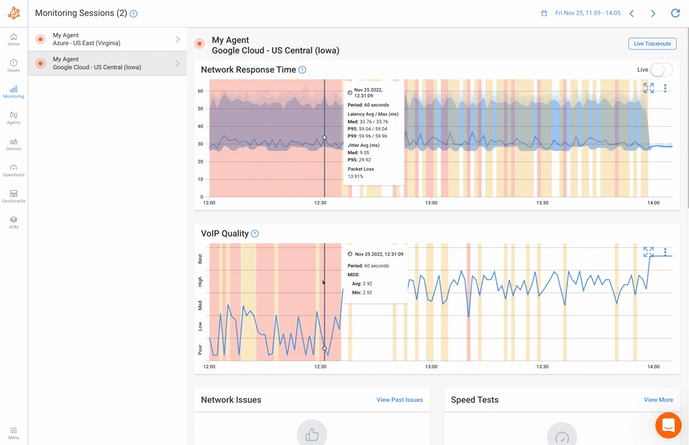
With Obkio, users gain access to real-time monitoring and reporting capabilities that enable them to assess network response time across their entire network infrastructure, encompassing routers, switches, and end-user devices.
This all-inclusive network monitoring solution not only detects network issues affecting network response time but also delivers valuable insights into network congestion, packet loss, and bandwidth utilization. By harnessing Obkio's robust feature set, organizations can proactively fine-tune their network performance, swiftly address network response time challenges, and ensure seamless and uninterrupted operations.
Obkio continuously measures network response time by:
- Deploying Network Monitoring Agents strategically in key network locations.
- Simulating network traffic with synthetic data streams.
- Sending synthetic traffic at 500 ms intervals, mirroring the round-trip time it takes for data to traverse the network.
- Identifying and addressing network response time issues impacting critical applications like VoIP and unified communications (UC).

Obkio’s Network Monitoring Solution will measure network response time by sending and monitoring data packets through your network every 500ms using Network Monitoring Agents. The Monitoring Agents are deployed at key network locations like head offices, data centers, and clouds and continuously measure the amount of time it takes for data to travel across your network.
To deploy network response time monitoring in all your network locations, we recommend deploying:
- Local Agents: Installed in the targeted location experiencing network response time issues. There are several Agent types available (all with the same features), and they can be installed on MacOS, Windows, Linux and more.
- Public Monitoring Agent: These are deployed over the Internet and managed by Obkio. They compare performance up to the Internet and quickly identify if network response time issues are global or specific to the destination. For example, measure network response time between your branch office and Google Cloud.
Once you’ve set up your Monitoring Agents for network response time monitoring, they’ll begin exchanging synthetic traffic to continuously measure network response time and other essential network metrics like latency, packet loss and jitter.
You can easily view and analyze network response time and other metrics on Obkio’s Network Response Time Graph.
Measure network response time throughout your network with updates every minute. This will help you understand if your network is responding as it should be. If you’re experiencing poor network response time, Obkio allows you to set thresholds, configure alerts, and further drill down to identify and troubleshoot network issues affecting network response time.
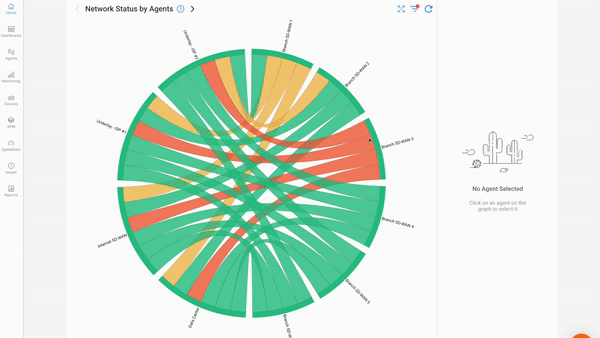
The most common and straightforward method to measure network response time is using the Ping utility. Although this method won’t give you a complete overview of your network performance, it can give you a quick idea about how your network is responding.
When you ping a destination IP address or hostname, your computer sends an ICMP (Internet Control Message Protocol) Echo Request packet to the destination, and the destination responds with an Echo Reply packet. The round-trip time displayed in the ping result represents the network response time. Ping is widely available on various operating systems.
1. Command Syntax:The Ping command is typically available on most operating systems, including Windows, macOS, and Linux. To use Ping, open your command prompt or terminal and enter the following syntax:
ping [destination]
[destination]can be either an IP address (e.g., 192.168.1.1) or a domain name (e.g., www.example.com). This is the target you want to ping to measure network response time.
2. Sending ICMP Echo Requests: When you execute the Ping command, your computer sends out ICMP Echo Request packets to the specified destination. These packets essentially say, "Hello, are you there?" to the destination.
3. Receiving ICMP Echo Replies: The destination, if reachable and responsive, will reply to these Echo Request packets with ICMP Echo Reply packets. The round-trip time for these packets to travel from your computer to the destination and back is what Ping measures.
4. Displayed Metrics: When you ping a destination, the command typically displays several metrics:
- Response Time (Latency): This is the key metric you're interested in. It's displayed in milliseconds (ms) and represents the round-trip time for the ICMP Echo Request and Echo Reply packets to travel. Lower values indicate faster response times.
- Packet Loss: Ping also reports the percentage of packets that were lost during the test. Packet loss can be an indicator of network congestion or connectivity issues.
- Time-to-Live (TTL): TTL is a value in the packet header that decrements with each hop (router) the packet traverses. Ping reports the TTL value for each response, which can help you understand the number of hops to the destination.
Ping is a valuable tool for quick and straightforward network response time measurements. However, it's essential to note that Ping measures ICMP traffic and may not always reflect the exact performance of other types of network traffic or applications. For more comprehensive network performance monitoring, specialized tools and techniques may be necessary.
Traceroute is another utility that not only measures network response time but also traces the route taken by packets to reach a destination. It shows response times for each hop along the path to the destination, helping identify where delays occur.
Traceroute, also known as tracert on Windows, is a command-line utility available on most operating systems. To use Traceroute, open your command prompt or terminal and enter the following syntax:
traceroute [destination]
[destination]should be the target (either an IP address or a domain name) to which you want to trace the network path and measure response times.
You can also use Obkio Vision, Obkio’s Free Visual Traceroute tool, as an easier and more graphical traceroute option. Obkio Vision interprets traceroute results for you and can be used as a standalone, or as part of Obkio’s complete Network Monitoring solution.
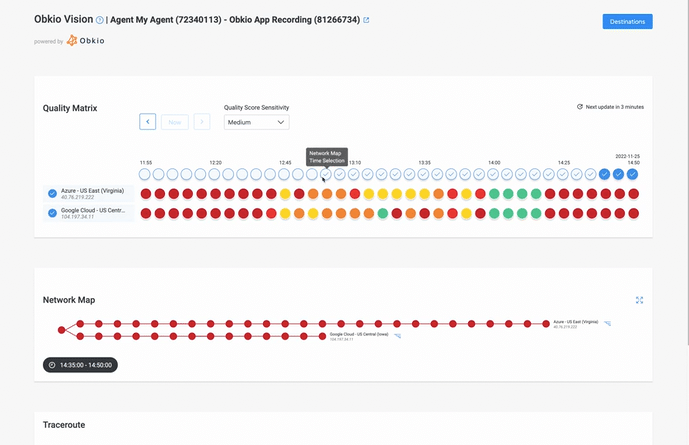
- Tracing the Route: When you execute the Traceroute command, it sends out a series of Internet Control Message Protocol (ICMP) Echo Request packets, similar to Ping. However, Traceroute differs in that it doesn't just measure network response times; it traces the entire network route taken by these packets from your computer to the destination.
- Hop-by-Hop Analysis: Traceroute displays a list of intermediate network devices (hops) that your packets traverse to reach the destination. It reports the IP addresses or hostnames of these devices, along with the response time (latency) for each hop.
- Response Time Metrics: Traceroute measures the response time for each hop in milliseconds (ms). The response time represents the round-trip time for an ICMP Echo Request packet to travel from your computer to the hop and back. Lower response times typically indicate faster network performance.
- Time-to-Live (TTL): Traceroute relies on the Time-to-Live (TTL) field in the IP packet header. The TTL starts with a certain value (e.g., 1) and increments by one for each hop. Routers along the path decrement the TTL value. When the TTL reaches zero, a router discards the packet and sends an ICMP Time Exceeded message back to the sender. Traceroute uses this mechanism to determine each hop.
- Identifying Delays: Traceroute is useful for identifying where delays or bottlenecks occur along the network path. You can analyze the response times at each hop to pinpoint areas of concern. High response times at specific hops may indicate network congestion or routing issues.
- Understanding Network Path: By visualizing the network path taken by your packets, Traceroute offers a more comprehensive view of the route compared to Ping. It can help you diagnose routing problems and understand which network segments are contributing to latency.
- Analyzing Results: To assess network response time using Traceroute, look for consistent and low response times throughout the path. Additionally, pay attention to any significant variations (jitter) and areas with high response times, as these may require further investigation.
Traceroute is a valuable tool for gaining insights into the network path and measuring response times. It's particularly helpful for diagnosing routing issues and identifying latency sources along the route.
However, like Ping, it focuses on ICMP traffic and may not precisely reflect the performance of other types of network traffic or applications. For comprehensive network performance monitoring, consider using specialized tools and techniques tailored to your specific needs.
Some applications and services have built-in mechanisms for measuring network response time. For example, web browsers often display page load times, and VoIP applications may show call latency metrics.
Web browsers play a crucial role in presenting content from websites, and they often include built-in tools for measuring and displaying network response time. Here's how they do it:
- Page Load Times: Web browsers typically report the time it takes to load a web page comprehensively. This measurement encompasses various components, including DNS resolution time, time to establish a secure connection (TLS/SSL handshake), time to download HTML, CSS, JavaScript, images, and other resources, and rendering time. These components collectively form the page load time. Faster page load times lead to a better user experience and improved search engine rankings.
- Developer Tools: Modern browsers come equipped with developer tools (e.g., Chrome DevTools, Firefox Developer Tools) that provide detailed insights into network performance. These tools display network waterfall charts, which visually represent the timing of each network request, including DNS, TCP, and TLS negotiation, as well as data transfer times. Developers and web administrators can use this information to optimize website performance.
VoIP applications and services rely on low network response times to ensure clear and real-time communication. To measure and manage network performance at the application level:
- Call Quality Metrics: VoIP applications often display call quality metrics, which include measurements like jitter (variation in latency), packet loss, and round-trip time (latency). These metrics help users and administrators assess the quality of VoIP calls. Low latency and minimal jitter are critical for smooth and uninterrupted conversations.
- Quality of Service (QoS) Dashboards: Enterprise-grade VoIP solutions often include QoS dashboards that provide real-time insights into network performance. These dashboards may offer call-level statistics, allowing administrators to monitor and troubleshoot call quality issues promptly.
In addition to application-specific metrics, there are specialized network performance monitoring tools and software designed to measure and report on network response times at the application level. These tools can provide a unified view of network performance for various applications, services, and protocols within an organization.
They offer features such as:
- Real-Time Monitoring: Continuously track network response times and latency for critical applications and services.
- Alerting: Set up network monitoring alerts based on predefined thresholds to be notified of performance issues as they occur.
- Historical Data: Store historical performance data to identify trends and patterns and facilitate capacity planning.
- Multi-Protocol Support: Monitor response times for various protocols and services, including web applications, databases, email, and more.
- User Experience Monitoring: Some tools offer user experience monitoring by simulating user interactions with applications and measuring response times from an end-user perspective.
Application-level measurement of network response time is vital for ensuring a positive user experience and the reliable operation of critical services. It enables organizations to proactively address performance issues, optimize application delivery, and meet service level agreements (SLAs).
By monitoring response times at the application level, businesses can ensure that their digital services are responsive, efficient, and deliver the best possible experience to users and customers.


Quality of Service (QoS) in networking refers to a set of techniques and mechanisms used to manage and prioritize network traffic based on specific criteria. QoS aims to ensure that different types of traffic receive the appropriate level of service in terms of bandwidth, latency, packet loss, and jitter to meet the requirements of various applications and users.
In enterprise networks, QoS metrics and network monitoring solutions can provide detailed insights into network response time for different types of traffic. This is particularly important in environments where different applications have varying latency tolerances.
QoS Metrics:
QoS metrics are a set of parameters and measurements used to assess the quality of network service. They include:
- Latency: Latency is one of the most critical QoS metrics. It measures the time it takes for data packets to travel from the source to the destination. Low latency is essential for real-time applications, while higher latency may be acceptable for non-real-time traffic.
- Jitter: Jitter is the variation in latency over time. Consistent and low jitter is vital for maintaining the quality of real-time applications like VoIP and video conferencing.
- Packet Loss: Packet loss occurs when data packets are dropped or not delivered to their intended destination. Minimizing packet loss is crucial for reliable data transmission and ensuring that all packets reach their destination.
- Bandwidth: QoS can allocate or reserve specific amounts of available bandwidth for different types of traffic. Applications with high bandwidth requirements, such as video streaming or backups, can benefit from bandwidth allocation.
For more comprehensive testing, especially in the context of load testing or stress testing applications, performance testing tools like Apache JMeter or LoadRunner can simulate multiple users or clients to measure response times under various conditions.
- Simulate Real-World Scenarios: Create scenarios that mimic user interactions to measure network response times.
- Generate Load: Control the number of virtual users to test under different levels of load.
- Record Response Times: Capture response times for transactions, requests, or interactions with applications or networks.
- Monitor and Analyze: Provide real-time monitoring and analysis, highlighting performance metrics and bottlenecks.
- Assess Variability: Evaluate network jitter and variability, crucial for real-time applications.
- Scenario and Load Balancing Testing: Test under specific conditions and assess load balancing effectiveness.
- Reporting and Capacity Planning: Generate reports, identify issues, and inform capacity planning efforts.
Performance testing tools are essential for ensuring network performance and delivering a positive user experience, particularly under challenging conditions.
Learn how to measure network performance with key network metrics like throughput, latency, packet loss, jitter, packet reordering and more!
Learn more

Network Response Time has a significant impact on overall network performance and can influence various aspects of a network's functionality and user experience. It's not merely a technical metric but a critical factor that can influence your organization's efficiency, productivity, and ultimately, its bottom line.
So let’s look into the implications of network response time, shedding light on how this metric can affect your network, operations, and user satisfaction.
- User Experience: The most immediate impact of network response time is on the user experience. Slow response times can lead to frustration among users, especially when accessing web applications or online services. It can result in longer loading times for websites, delays in data retrieval, and sluggish responsiveness in applications, all of which can drive users away.
- Productivity: In a business context, network response time directly affects employee productivity. Slow network performance can lead to delays in accessing critical business applications, sharing files, and collaborating with team members. This, in turn, can reduce overall work efficiency and output.
- Real-Time Applications: Network response time is particularly crucial for real-time applications like video conferencing, VoIP (Voice over Internet Protocol), and online gaming. High response times can result in lag, jitter, and dropped calls, making these applications practically unusable.
- Data Transfer: In data-intensive operations, such as transferring large files or backups over the network, slow response times can significantly increase the time it takes to complete these tasks. This can impact data backup schedules and affect data availability for critical operations.
- Network Reliability: Slow response times can be an early warning sign of network issues, such as congestion or equipment failures. Monitoring response times can help IT teams identify and address these problems before they escalate.
- Service Level Agreements (SLAs): Many businesses have SLAs with service providers or cloud services that specify acceptable response time thresholds. Failing to meet these SLAs can result in financial penalties or service disruptions.
Network response time measurements can vary significantly based on factors such as the type of network, the applications running on it, and user expectations. What is considered good or bad network response time depends on the specific context and the requirements of the system or application.
Here's a general guideline to help you assess network response time:
- Low Latency: In general, lower network response times (latency) are good latency levels. For most applications, network latency under 50 milliseconds (ms) is considered excellent. This level of latency provides a near-instantaneous response, which is ideal for applications like web browsing, video streaming, and online gaming.
- Real-Time Applications: For real-time applications like VoIP, video conferencing, and online gaming, network latency should be even lower, ideally under 20 ms. These applications require low latency to maintain smooth and uninterrupted communication.
- Consistency: Beyond the absolute value of latency, consistency is crucial. Good network response times should have minimal variation or jitter. Consistency ensures a reliable and predictable user experience.
- Meeting SLAs: For businesses with service level agreements (SLAs) with customers or partners, good network response time meets or exceeds the specified service or Internet SLA requirements.
- User Satisfaction: Ultimately, good network response time leads to high user satisfaction. It's important to align response time expectations with the specific needs and preferences of the end-users.
- Moderate Latency: In some scenarios, moderate latency, ranging from 50 ms to 100 ms, may be acceptable. For instance, for non-real-time applications like email, file downloads, and web browsing, users may not notice or be significantly affected by latency in this range.
- Bulk Data Transfers: Applications involving large data transfers, such as file backups or software updates, can tolerate higher latency as long as it doesn't result in excessive delays.
- High Latency: Network response times exceeding 100 ms are generally considered poor for most applications. Users may experience delays, sluggishness, and frustration, particularly in real-time or interactive applications.
- Packet Loss: High packet loss rates, regardless of latency, can severely impact network performance. Even low latency is ineffective if a significant portion of data packets is lost in transit.
- Inconsistency: Network response times with high jitter or significant variations are considered poor, as they lead to an unpredictable user experience and can disrupt real-time applications.
- Frequent Outages: Frequent network outages or disconnections result in bad response times and disrupt user activities.
- Exceeding SLAs: Failure to meet service level agreements (SLAs) is typically an indication of poor network response time for business-critical applications.
Remember that what's considered good or bad network response time varies depending on the use case. Critical applications like financial trading platforms or emergency response systems demand extremely low latency, while non-real-time applications like email may tolerate higher latency.
It's essential to align network response time goals with the specific requirements and expectations of your users and applications. Regular monitoring and network optimization are vital to maintaining a satisfactory network experience.
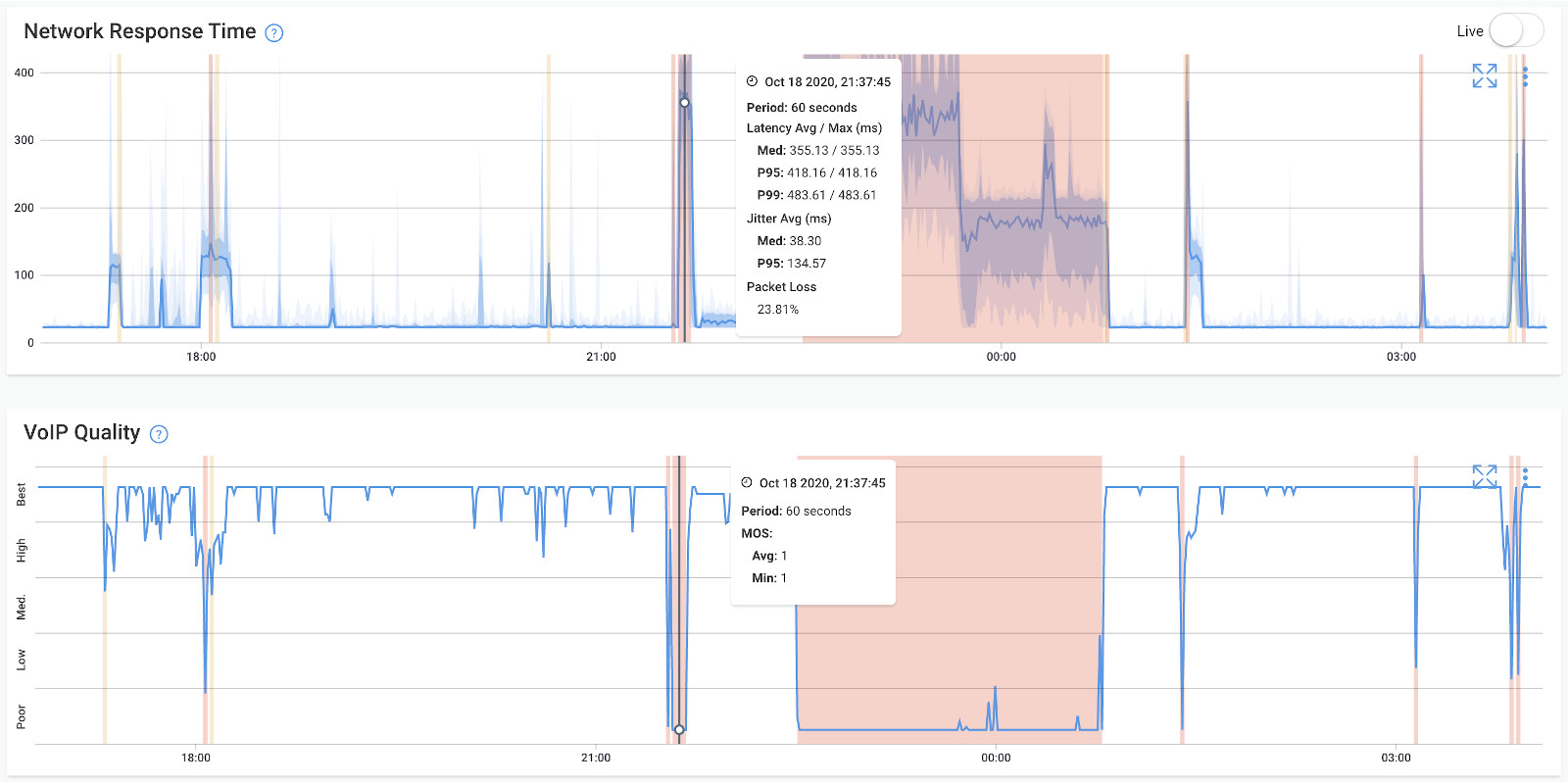

Network response time is a pivotal metric that influences the performance and satisfaction of both end-users and critical applications within your network. In this section, we explore the multifaceted impact of network response time on various facets of your network, from the user experience to application performance and the overall efficiency of your network infrastructure.
Measuring network response time using a Network Monitoring tool, like Obkio, will show you the effect of network response time on every end of your network. Nonetheless, understanding these effects is essential for optimizing your network's responsiveness and ensuring seamless operations.
- Satisfaction: Network response time directly influences the satisfaction of end-users. Faster response times lead to a smoother and more enjoyable user experience, while longer response times can frustrate users.
- Productivity: In business environments, network response time affects employee productivity. Slow networks can lead to wasted time, especially for tasks that involve accessing remote resources or cloud-based applications.
- Real-Time Applications: Network response time is critical for real-time applications like VoIP, video conferencing, and online gaming. High latency can result in poor call quality, video stuttering, and lag during gaming sessions.
- Web Browsing: Slow response times for web pages and web applications can lead to higher bounce rates, reduced engagement, and lower conversion rates for online businesses.
- Web Applications: Sluggish network response times can make web applications unresponsive and lead to longer page load times. This affects the overall usability of websites and web-based services.
- Database Access: In database-driven applications, network response time impacts the speed at which data is retrieved and transactions are processed. Slow responses can lead to application timeouts and data retrieval delays.
- Cloud Services: Cloud-based applications and services rely heavily on network response time. Slow connections to cloud resources can hinder the performance of cloud-hosted applications.
- Data Transfer: High network latency can affect data transfer rates, particularly for large files or backups. Slow response times can extend the time required for data synchronization and backup processes.
- Bandwidth Utilization: Slow response times may lead to inefficient use of network bandwidth, as users or applications may retry requests due to perceived delays, increasing network congestion.
- Router and Switch Load: High network response times can result in increased router and switch processing loads as they handle retransmitted packets and routing decisions.
- Queue Congestion: Delays in network response time can lead to queue congestion at network devices, causing packet drops and deteriorating overall network performance.
- Load Balancing: Load balancing systems may struggle to distribute traffic effectively when network response times vary significantly between servers or resources.
- Application Bottlenecks: Slow network response times can expose application bottlenecks, where the application's performance is limited by the speed at which it can receive or send data over the network.
- Resource Utilization: Inefficient network response times can lead to increased resource utilization on servers, as they wait for network requests to complete.
- Service Availability: Prolonged network response times can trigger timeouts and service disruptions, affecting the availability of applications and services.
- Security: Slow response times can impact security measures like intrusion detection systems (IDS) and firewall rules that rely on network traffic analysis.
In summary, network response time has a cascading effect on various aspects of your network. It directly impacts user experience, application performance, and the efficiency of your network infrastructure. Monitoring and optimizing network response times are essential for ensuring a responsive, reliable, and efficient network environment.
When measuring network response time, it's essential to consider a range of complementary metrics to gain a comprehensive understanding of network performance. When using Obkio’s Network Monitoring tool, Obkio will automatically measure these network metrics to give you a comprehensive view of your network performance - so you don’t have to do it yourself.
Here are some key metrics to consider alongside network response time:
- Latency: Network response time is a subset of network latency, which includes the time it takes for data to travel from the source to the destination. Latency metrics such as one-way latency and round-trip time (RTT) provide insights into the speed of data transmission.
- Jitter: Jitter measures the variation in latency over time. It is crucial for real-time applications like VoIP and video conferencing, where consistent, low jitter is essential for maintaining quality and smooth communication.
- Packet Loss: Packet loss is the percentage of data packets that do not reach their destination. High packet loss rates can disrupt data transmission and adversely affect application performance.
- Bandwidth Utilization: Monitoring the utilization of network bandwidth helps ensure that the network is not congested, which can impact response times. High bandwidth utilization can result in latency and packet loss.
- Throughput: Throughput measures the actual data transfer rate on the network. It represents the amount of data that can be transmitted in a given time frame. Low throughput may indicate network congestion, network overload or limitations.
- Error Rates: Keeping track of error rates, such as CRC errors or frame loss, is essential for identifying and troubleshooting issues with the physical network infrastructure.
- Packet Delay Variation (PDV): PDV is another metric related to jitter, but it specifically focuses on the variance in packet arrival times. It helps assess the predictability of network performance.
- Quality of Service (QoS) Metrics: QoS metrics, including those related to network response time, are vital for ensuring that different types of traffic receive the appropriate level of service. This may involve defining and monitoring metrics like latency thresholds for specific traffic classes.
- Server-Side Metrics: When measuring network response time for server-based applications, consider metrics related to server performance, such as CPU usage, memory utilization, and disk I/O. These metrics can impact application responsiveness.
- User Experience Metrics: For a holistic view of network performance, assess user experience metrics like page load times for web applications, call quality for VoIP, or application-specific performance indicators.
- Geographical Metrics: In global networks, consider the geographical distribution of users and resources. Metrics related to data travelling across long distances can provide insights into the impact of network geography on response times.
- Service-Level Agreements (SLAs): Align network response time metrics with SLAs if they exist. SLA monitoring and meeting SLA requirements is often a critical performance goal.
- Historical Data: Keeping historical performance data allows you to identify trends, patterns, and potential performance degradation over time.
- Real-User Monitoring (RUM): RUM tools capture performance data from actual end-user interactions, providing a valuable perspective on network response time from the user's point of view.
- Application-Specific Metrics: Depending on the applications in use, you may need to consider application-specific metrics, such as database query times, transaction processing times, or video streaming quality.
Choosing the right combination of these metrics depends on your network's specific use cases, goals, and the applications you're supporting. Collecting and analyzing these metrics collectively provides a comprehensive picture of network performance and helps you identify and address issues promptly.
Explore what is packet loss, how packet loss impacts network performance, and how to reduce packet loss to minimize its impact on businesses.
Learn more

Network response time is not just a technical metric; it's a critical factor that underpins user satisfaction, application performance, and the success of businesses and organizations.
In this section, let’s go over the importance of network response time monitoring and how it influences user experiences, productivity, competitive advantage, and more. Understanding why network response time matters is the first step toward optimizing network performance and achieving business goals.
- User Satisfaction: Network response time significantly influences how users perceive the performance of applications and services. Faster response times lead to a more enjoyable and productive user experience, while slow response times can frustrate users and reduce satisfaction.
- Productivity: In business settings, network response time affects employee productivity. Slow networks can lead to delays in accessing critical resources, resulting in wasted time and reduced efficiency.
- Real-Time Applications: Network response time is paramount for real-time applications such as VoIP, video conferencing, online gaming, and financial trading. Low latency and minimal jitter are essential for maintaining clear and uninterrupted communication and minimizing lag in gaming environments.
- Web Performance: In the digital age, web performance is crucial for online businesses. Faster response times for web applications and websites lead to lower bounce rates, increased engagement, and higher conversion rates.
- Competitive Advantage: Organizations that prioritize network response time gain a competitive edge. Faster-loading websites and responsive applications are more likely to attract and retain customers.
- Service Availability: Slow network response times can lead to timeouts, service disruptions and network disconnections, affecting the availability of applications and services. Reliable and responsive networks are essential for business continuity.
- Customer Satisfaction: In customer-centric industries, such as e-commerce and online services, network response time directly impacts customer satisfaction and loyalty. Slow websites and applications can drive customers away.
- Operational Efficiency: Efficient network response times are essential for efficient data transfers, backups, and synchronization processes. Slow network responses can extend the time required for these operations.
- Resource Utilization: Slow response times can lead to increased resource utilization on servers and networking equipment as they wait for network requests to complete. Optimizing response times can lead to more efficient resource usage.
- Meeting SLAs: Many businesses have service level agreements (SLAs) with customers or partners that specify expected response times. Meeting or exceeding these SLAs is often a contractual obligation.
- Security: Slow response times can impact security measures like intrusion detection systems (IDS) and firewall rules that rely on network traffic analysis. Rapid threat detection and response depend on network responsiveness.
- User Retention: Slow-loading websites and unresponsive applications can lead to user frustration and abandonment. A responsive network helps retain users and keeps them engaged.
- Data Integrity: In applications that involve data synchronization and replication, network response time affects the accuracy and integrity of data transfers. Fast and reliable responses are critical for maintaining data consistency.
In summary, network response time is a critical metric that directly affects user satisfaction, application performance, and business outcomes. Prioritizing and optimizing network response time is essential for delivering a superior user experience, remaining competitive, and meeting the performance expectations of both users and business stakeholders.
A network response time test, often referred to simply as a "response time test" or "ping test," is a diagnostic procedure used to measure the time it takes for data to travel from a source point to a destination point in a network and then back to the source.
This measurement is commonly referred to as "round-trip time" (RTT) and is typically expressed in milliseconds (ms).
Here's how a network response time test works and why it's essential:
1. Selection of Source and Destination:
In a response time test, you choose a specific source point (your computer or a network device) and a destination point (another computer, server, or network device) within the same network or on the internet.
2. Sending Test Packets:
The source point sends a series of test packets to the destination point. These packets are typically small data packets, often using the Internet Control Message Protocol (ICMP), such as those used in the common "ping" utility.
3. Routing and Transmission:
The test packets are transmitted through the network infrastructure, including routers and switches, following the network path from the source to the destination.
4. Round-Trip Measurement:
When the destination point receives each test packet, it immediately sends a response back to the source point. The time it takes for the packet to travel from the source to the destination and then back to the source is recorded as the round-trip time or network response time.
5. Multiple Test Packets:
Typically, multiple test packets are sent in quick succession (e.g., every second), and the response time for each packet is recorded. This allows you to calculate an average response time and assess the consistency of network performance.
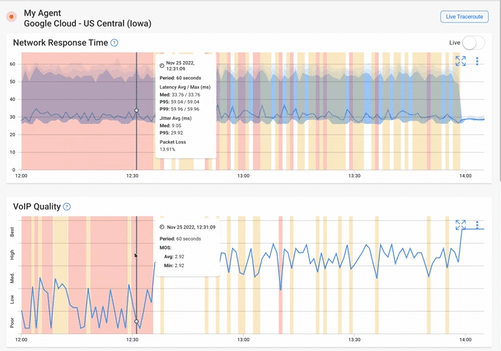
- Performance Monitoring: Response time tests are fundamental for network performance monitoring. By regularly measuring response times, you can identify trends, diagnose issues, and ensure network responsiveness meets expectations.
- Troubleshooting: In the event of network problems or slowdowns, response time tests can help pinpoint the location and cause of performance issues and facilitate network troubleshooting. High response times may indicate network congestion, routing problems, or hardware failures.
- Benchmarking: Response time tests provide a network baseline for network performance. You can compare current response times to historical data or industry benchmarks to assess whether your network is performing within acceptable parameters.
- Quality of Service (QoS): Response time tests are essential for evaluating network Quality of Service (QoS) metrics, which are crucial for prioritizing and managing different types of traffic effectively.
- SLA Compliance: Service providers often include response time metrics in Service Level Agreements (SLAs). Response time tests help ensure that providers meet their contractual commitments.
- User Experience: Slow network response times can lead to a poor user experience, affecting productivity and user satisfaction. Regular response time tests can help preemptively address performance issues before they impact users.
- Capacity Planning: Response time tests assist in capacity planning by providing insights into how well the network can handle current and future demands. They help organizations allocate resources effectively.
In summary, network response time tests are essential tools for assessing and maintaining network performance. They provide valuable data for performance monitoring, troubleshooting, and ensuring a responsive and efficient network infrastructure.
As we conclude this article, we've explored the importance of network response time and strategies for optimizing it. Now, let's summarize with some actionable tips that you can implement to improve your network's responsiveness and ensure a smooth and efficient network experience.
Optimizing and improving network response time is essential for delivering a responsive and efficient network experience. Here are some tips to help you achieve better network response time!
1. Analyze and Monitor Performance:
- Regularly monitor network performance using response time tests and other relevant metrics to identify areas that need improvement.
- Use network monitoring tools to gain insights into network latency, packet loss, jitter, and other network metrics.
2. Optimize Network Infrastructure:
- Upgrade network hardware and equipment to support higher data rates and reduce latency. Ensure routers, switches, and cables are of high quality and up to date.
- Implement redundant network paths to reduce downtime in case of failures and to distribute network traffic effectively.
3. Reduce Network Congestion:
- Implement Quality of Service (QoS) policies to prioritize critical traffic and ensure it gets sufficient bandwidth and lower latency.
- Use traffic shaping and traffic policing to control and manage bandwidth usage, preventing congestion during peak usage times.
4. Content Delivery Networks (CDNs):
- Employ CDNs to cache and serve content closer to end-users. CDNs reduce the distance data must travel, resulting in lower response times for web content.
5. Optimize Routing and Traffic Management:
- Review and optimize routing tables to ensure efficient data transmission paths.
- Implement traffic engineering techniques to balance traffic loads across multiple routes and reduce latency.
6. Implement Caching:
- Implement caching mechanisms for frequently accessed data or content to reduce the need to fetch data from the source each time.
- Browser caching and content caching proxies can significantly improve web page load times.
7. Minimize Packet Loss and Jitter:
- Address packet loss issues by identifying and fixing network problems, such as faulty hardware or congested links.
- Implement jitter buffers and buffering techniques for real-time applications to smooth out variations in latency.
8. Optimize Application Performance:
- Optimize application code and database queries to reduce data transfer times and improve application responsiveness.
- Implement data compression techniques to reduce the size of data packets, resulting in faster transmission.
9. Prioritize and Manage Network Traffic:
- Use traffic management and shaping techniques to prioritize critical traffic types, such as VoIP or video conferencing, over less time-sensitive traffic.
- Limit or control bandwidth-intensive applications to prevent them from consuming excessive network resources.
10. Load Balancing:
- Implement network load balancing to distribute network traffic evenly across multiple servers or resources. Load balancing can prevent overloading of specific network segments.
11 Security Measures:
- Ensure that security measures, such as firewalls and intrusion detection systems, do not introduce unnecessary latency. Configure them for optimal performance.
12. Content Optimization:
- Compress images and other media files to reduce their size and improve web page load times.
- Use content delivery techniques like GZIP compression to reduce data transmission overhead.
13. DNS Optimization:
- Optimize Domain Name System (DNS) performance by using efficient DNS servers, minimizing DNS lookups, and implementing DNS caching.
14. Regular Maintenance and Updates:
- Keep network hardware and software up to date by applying patches and firmware updates.
- Conduct regular network audits and maintenance to identify and address potential performance bottlenecks.
15. Capacity Planning:
- Continuously assess network capacity and plan for future growth to avoid congestion and ensure responsive performance.
16. User Education:
- Educate users about best practices to reduce network congestion, such as avoiding large downloads during peak hours.
17. Testing and Benchmarking:
- Conduct performance testing and benchmarking to ensure that network improvements have the desired impact on response times.
Remember that network optimization is an ongoing process. Regularly assess network performance, adjust configurations, and implement new technologies to keep response times at an optimal level, meeting the evolving needs of your organization and users.
As we wrap up our journey through the world of network response time, one thing is crystal clear: A snappy network makes everyone happier! It boosts user experiences, keeps the productivity flowing, and ultimately helps your business thrive.
Now, before you go, here's a tip: If you want to keep your network in tip-top shape and ensure it's running like a finely-tuned sports car, give Obkio's Network Monitoring tool a spin. It's like having a supercharged GPS for your network, helping you measure response time, find and fix hiccups, and keep your digital highways running smoothly.

Don't miss out on the chance to turbocharge your network's performance! Try Obkio today and give your network the TLC it deserves. Your network's journey to peak performance starts right here.
- 14-day free trial of all premium features
- Deploy in just 10 minutes
- Monitor performance in all key network locations
- Measure real-time network metrics
- Identify and troubleshoot live network problems



























 Obkio Blog
Obkio Blog










